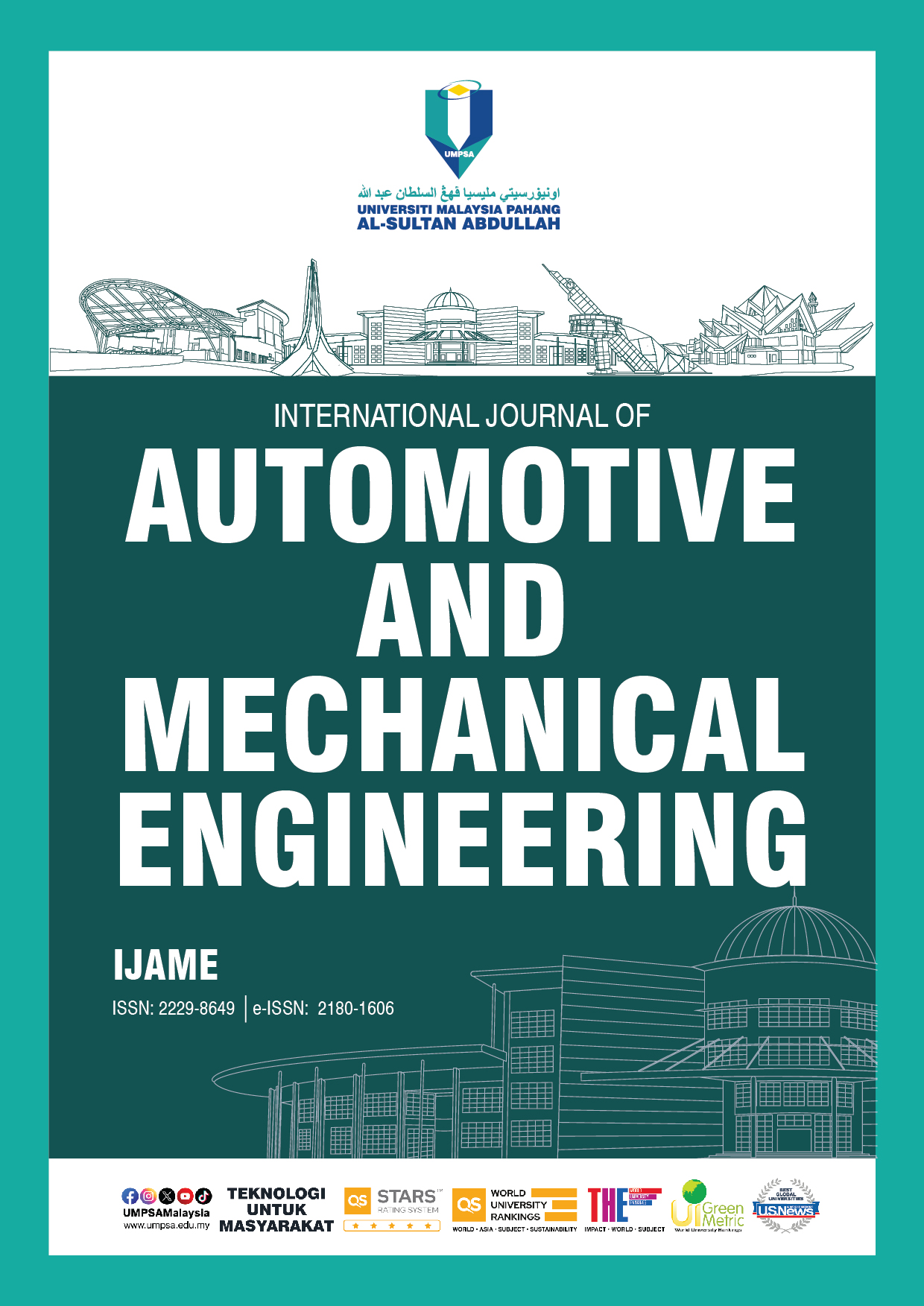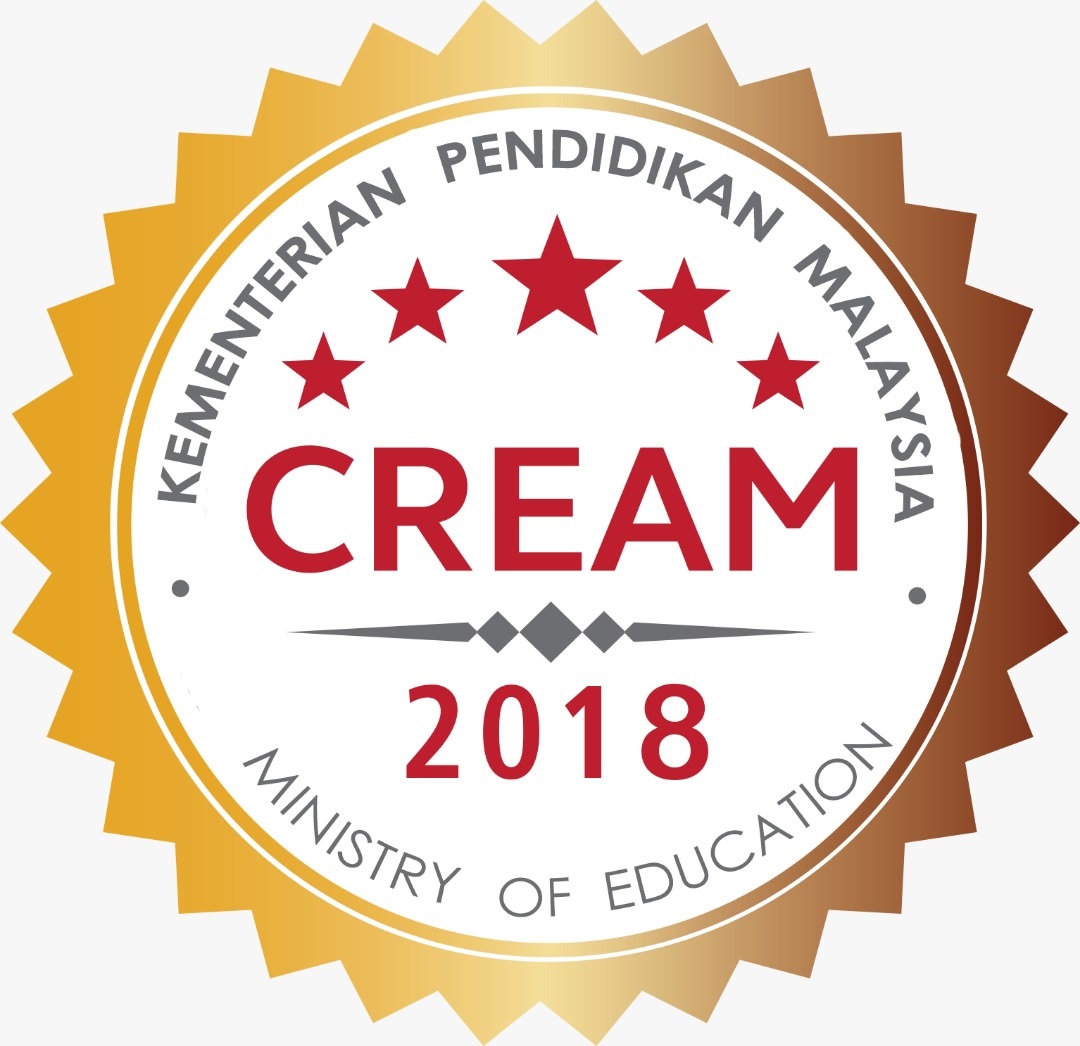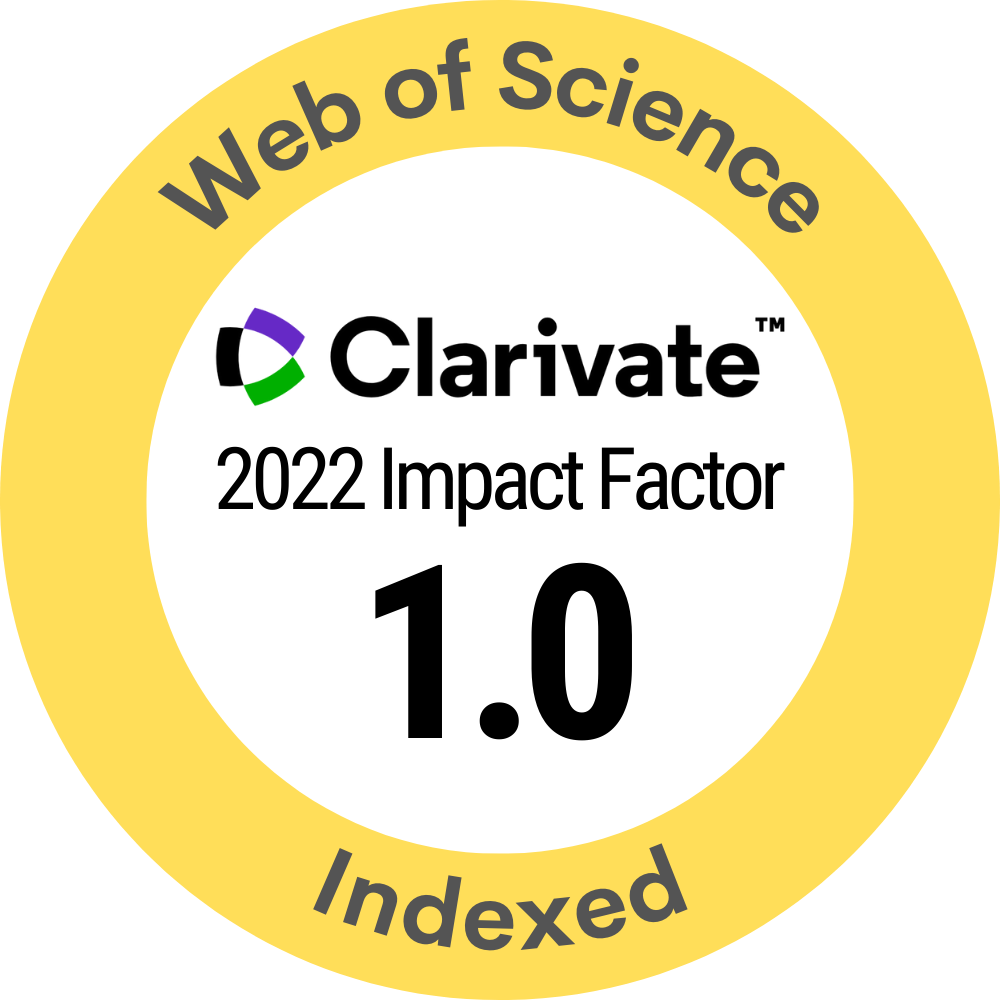Experimental Analysis of Thermodynamic Performance for 2.5 kW Split Inverter Air Conditioning Unit with R-410A
DOI:
https://doi.org/10.15282/ijame.22.2.2025.11.0948Keywords:
Energy efficiency ratio, Temperature differential, Inverter air conditioning, ThermodynamicsAbstract
This research aims to investigate the thermodynamic performance, including temperature differential properties and energy efficiency ratio (EER) of the air conditioning cooling system. A 2.5 kW split inverter air conditioning with R-410A was applied in this research for investigation and integrated with a microcontroller ATmega 2560 for data acquisition. The investigation was carried out between temperature setpoint of 16°C and 20°C. An online psychrometric chart calculator was employed in this research to facilitate the calculation of thermodynamic properties. The results showed that the average temperature differential across all the temperature setpoint was found to be 11°C to 12.89°C. This result indicated an ability to exceed the minimum tolerance allowed for evaporator temperature differential standards. Moreover, the highest result of the EER of the air conditioning system was 13.87 at a temperature setpoint of 20°C. The research revealed that all temperature setpoint ranging from 16°C to 20°C yielded EER values within the range of 8 to 15, which is widely recognized as the efficient operational range for residential air conditioning applications. In addition, this air conditioning system has better energy efficiency and cost savings over the lifetime of the cooling system. The integration of microcontroller technology in this research facilitated the real-time recording of each investigation parameter. This approach enhanced the efficiency, complexity, and reliability of the experimental investigation of the air conditioning system.
References
[1] M. Dai, H. Li, X. Li, and S. Wang, “Reconfigurable supply-based feedback control for enhanced energy flexibility of air-conditioning systems facilitating grid-interactive buildings,” Advances in Applied Energy, vol. 14, p. 100176, 2024.
[2] T. Randazzo, F. Pavanello, and E. De Cian, “Adaptation to climate change: Air-conditioning and the role of remittances,” Journal of Environmental Economics and Management, vol. 120, p. 102818, 2023.
[3] I. M. Rasta and I. N. Suamir, “The role of vegetable oil in water based phase change materials for medium temperature refrigeration,” Journal of Energy Storage, vol. 15, pp. 368–378, 2018.
[4] H. Zhu, S. Hu, G. Wang, L. Han, M. Jing, and X. Zhao, “Full-scale numerical simulation and experimental validation of the thermal environment under the heating mode in an air-conditioned room,” Case Studies in Thermal Engineering, vol. 51, p. 103548, 2023.
[5] M. H. Alhamdo, M. A. Theeb, and J. J. Abdulhameed, “Performance Improvement of an Air-Conditioning System During Refrigerant Evaporation,” Journal of Engineering and Sustainable Development, vol. 2018, no. 6, pp. 101–113, 2018.
[6] Á. Andrade, Á. Restrepo, and J. E. Tibaquirá, “EER or Fcsp: A performance analysis of fixed and variable air conditioning at different cooling thermal conditions,” Energy Reports, vol. 7, pp. 537–545, 2021.
[7] S. Sheng, T. Yamanaka, T. Kobayashi, N. Choi, and S. Yodono, “Draft-free air conditioning through split membrane ceiling system_ An exploratory study,” Indoor Environments, vol. 1, no. 2, p. 100017, 2024.
[8] D. Lee and S. T. Lee, “Artificial intelligence enabled energy-efficient heating, ventilation and air conditioning system: Design, analysis and necessary hardware upgrades,” Applied Thermal Engineering, vol. 235, p. 121253, 2023.
[9] S. Alshammari, S. T. Kadam, and Z. Yu, “Assessment of single rotor expander-compressor device in combined organic Rankine cycle ( ORC ) and vapor compression refrigeration cycle ( VCR ),” Energy, vol. 282, p.128763, 2023.
[10] S. A. Bhat, U. Sajjad, I. Hussain, W. M. Yan, H. M. U. Raza, H. M. Ali, M. Sultan, H. Omar, M. W. Azam, F. Bozzoli, and N. F. Huang, “Experiments and modeling on thermal performance evaluation of standalone and M-cycle based desiccant air-conditioning systems,” Energy Reports, vol. 11, pp. 1445–1454, 2024.
[11] C. Liang, F. Zha, and X. Li, “Low-grade energy-bus air conditioning system using energy efficient three-fluid heat exchange terminals,” Next Energy, vol. 3, p. 100098, 2024.
[12] M. H. Alhamdo, M. A. Theeb, and J. J. Abdulhameed, “Using Evaporative Cooling Methods for Improving Performance of an Air-cooled Condenser,” Universal Journal of Mechanical Engineering, vol. 3, no. 3, pp. 94–106, 2015.
[13] M. Schweizer, M. Stöckl, R. Tutunaru, and U. Holzhammer, “Influence of heating, air conditioning and vehicle automation on the energy and power demand of electromobility,” Energy Conversion and Management: X, vol. 20, 2023.
[14] T. Yamamoto, A. Ozaki, K. Aratsu, and R. Fukui, “Energy simulation and CFD coupled analysis for the optimal operation of combined convection and radiant air conditioning considering dehumidification,” Heliyon, vol. 9, no. 7, p. e18092, 2023.
[15] H. Omar, U. Sajjad, I. Hussain, S. A. Bhat, M. Sultan, H. M. Ali, K. Hamid, and W. Yan, “Influence of the process and regeneration air conditions on the thermal performance of various desiccant air-conditioning systems,” Energy Conversion and Management: X, vol. 22, p. 100582, 2024.
[16] D. Saad and M. S. Kassim, “Effect of Baffles Geometry on Heat Transfer Enhancement inside Corrugated Duct,” International Journal of Mechanical Engineering and Technology (IJMET), vol. 10, no. 03, pp. 555–566, 2019.
[17] H. Zhang, C. Fan, T. Xiong, G. Liu, and G. Yan, “Improving performance of air conditioning system by using variable-circuit heat exchanger: Based on the Chinese APF standard,” Case Studies in Thermal Engineering, vol. 50, p. 103422, 2023.
[18] J. Li and B. Li, “Scenario analysis of hydrofluorocarbons consumption and emission reduction in China’s mobile air-conditioning sector,” Energy Reports, vol. 11, pp. 3171–3185, 2024.
[19] A. Andrade, J. Zapata-Mina, and A. Restrepo, “Exergy and environmental assessment of R-290 as a substitute of R-410A of room air conditioner variable type based on LCCP and TEWI approaches,” Results in Engineering, vol. 21, p. 101806, 2023.
[20] A. Esmaeel, A. Rahimnejad, and S. A. Gadsden, “Home energy management system for smart buildings with inverter-based air conditioning system,” International Journal of Electrical Power and Energy Systems, vol. 133, p. 107230, 2021.
[21] L. Zhu, J. Hong, S. Yang, Z. Hu, Y. Shao, and C. Wu, “Online modeling of virtual energy storage for inverter air conditioning clusters in CDL-based demand response,” Energy Reports, vol. 9, no. 2023, pp. 2024–2034, 2024.
[22] S. Liu, W. Ge, and X. Meng, “Influence of the shading nets on indoor thermal environment and air-conditioning energy consumption in lightweight buildings,” Energy Reports, vol. 11, pp. 4515–4521, 2024.
[23] Y. Ding and J. Fournier, “Modeling and analysis of inverter air conditioners for primary 15th analysis Modeling and air conditioners for primary frequency control considering signal delays and detection errors frequency control considering signal delays and detection errors Assess,” Energy Procedia, vol. 158, pp. 4003–4010, 2019.
[24] R. Conte, M. Azzolin, S. Bernardinello, and D. Del Col, “Experimental investigation of large scroll compressors working with six low-GWP refrigerants,” Thermal Science and Engineering Progress, vol. 44, p. 102043, 2023.
[25] J. Bai, H. Fan, S. Cui, L. Wang, S. He, M. Chen, and H. Zheng, “Experimental study of phase change heat dissipation system based on hydrogen fuel cell,” Case Studies in Thermal Engineering, vol. 59, p. 104495, 2024.
[26] F. Guo, Z. Chen, and F. Xiao, “Fault detection and diagnosis of electric bus air conditioning systems incorporating domain knowledge and probabilistic artificial intelligence,” Energy and AI, vol. 16, p. 100364, 2024.
[27] W. Watcharajinda, A. Asanakham, T. Deethayat, and T. Kiatsiriroat, “Performance study of open pond as heat sink of water-cooled air conditioner,” Case Studies in Thermal Engineering, vol. 25, p. 100988, 2021.
[28] A. S. Kvalsund and D. Winkler, “Development of an Arduino-based , open-control interface for hardware in the loop applications,” HardwareX, vol. 16, p. e00488, 2023.
[29] B. Nast, A. Reiz, and K. Sandkuhl, “Iot-based diagnostic assistance for energy optimization of air conditioning facilities,” Procedia Computer Science, vol. 219, pp. 416–421, 2023.
[30] A. Abolore, D. Olurotimi, O. Edward, H. Olajumoke, and F. Nihinlola, “Arduino microcontroller based real-time monitoring of haemodialysis process for patients with kidney disease,” e-Prime - Advances in Electrical Engineering, Electronics and Energy, vol. 7, p. 100403, 2024.
[31] K. Confidence, L. Bokopane, and K. Kusakana, “Real-time power dispatch in a standalone hybrid multisource distributed energy system using an Arduino board,” Energy Reports, vol. 7, pp. 479–486, 2021.
[32] J. Ham, Y. Shin, M. Lee, and H. Cho, “Investigation of performance and energy cost of automobile air-conditioner using alternative refrigerants based on thermal comfort using various cooling seats,” Results in Engineering, vol. 20, p. 101541, 2023.
[33] P. Sphicas and A. Pesyridis, “Investigation of the temporal behavior of desiccant disk for use in dehumidifiers and air conditioners,” Results in Engineering, vol. 21, p. 101801, 2024.
[34] J. J. Abdulhameed, M. S. Kassim, and M. S. Kadhim, “Experimental investigation of a condenser air humidity effect on superheated degree of compressor,” Journal of Mechanical Engineering Research and Developments, vol. 44, no. 5, pp. 167–176, 2021.
[35] A. Y. Sulaiman, G. I. Obasi, R. Chang, H. S. Moghaieb, J. D. Mondol, M. Smyth, B. Kamkari, and N. J. Hewitt, “A solar powered off-grid air conditioning system with natural refrigerant for residential buildings: A theoretical and experimental evaluation,” Cleaner Energy Systems, vol. 5, p. 100077, 2023.
[36] G. K. Murugesan, C. Murugesan, and S. Tamilkolundu, “Assessment of performance and sustainability of waste heat dryer coupled with air conditioner unit during drying of banana slices,” Case Studies in Thermal Engineering, vol. 59, p. 104506, 2024.
[37] M. Marwan, ST. N. Jabir, H. Hamdani, P. Purwito, A. Aksan, M. Thahir, Ruslan L, S. Sonong, M. Latief, and A. Pangkung, “Temperature Control Strategy to Mitigate Electrical Energy Cost for Air Conditioning,” e-Prime - Advances in Electrical Engineering, Electronics and Energy, vol. 7, p. 100410, 2024.
[38] C. Chen, H. Yang, X. Li, L. Chen, and M. Shi, “Optimization of solar and heat pump complementary powered desiccant air conditioning system,” Journal of Building Engineering, vol. 87, p. 109084, 2024.
[39] P. Zi, P. Luo, C. Wang, Q. Wang, B. Zhao, J. Hao, and T. Lan, “Modeling method of variable frequency air conditioning load,” Energy Reports, vol. 9, pp. 1011–1017, 2023.
[40] F. Guo, Z. Chen, and F. Xiao, “Fault detection and diagnosis of electric bus air conditioning systems incorporating domain knowledge and probabilistic artificial intelligence,” Energy and AI, vol. 16, p. 100364, 2024.
[41] A. Venkateshvaran et al., “A novel echocardiographic estimate of pulmonary vascular resistance employing the hydraulic analogy to Ohm ’ s law,” IJC Heart & Vasculature, vol. 42, p. 101121, 2022.
[42] P. L. C. Chua. Y. Takane, C. F. Sheng Ng, K. Oka, Y. Honda, Y. Kim, and M. Hashizume, “Net impact of air conditioning on heat-related mortality in Japanese cities,” Environment International, vol. 181, p. 108310, 2023.
[43] K. Z. Zhao and Z. Y. Su, “Experimental study on refrigeration system performance of pure electric refrigerator car based on medium pressure air supply,” e-Prime - Advances in Electrical Engineering, Electronics and Energy, vol. 7, p. 100399, 2024.
Downloads
Published
Issue
Section
License
Copyright (c) 2025 The Author(s)

This work is licensed under a Creative Commons Attribution-NonCommercial 4.0 International License.







